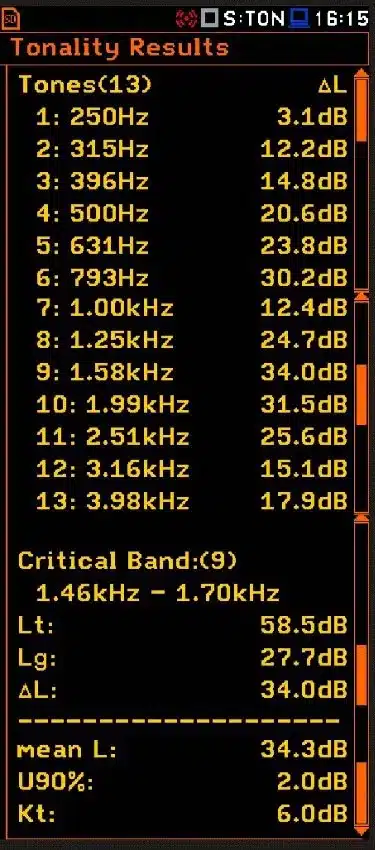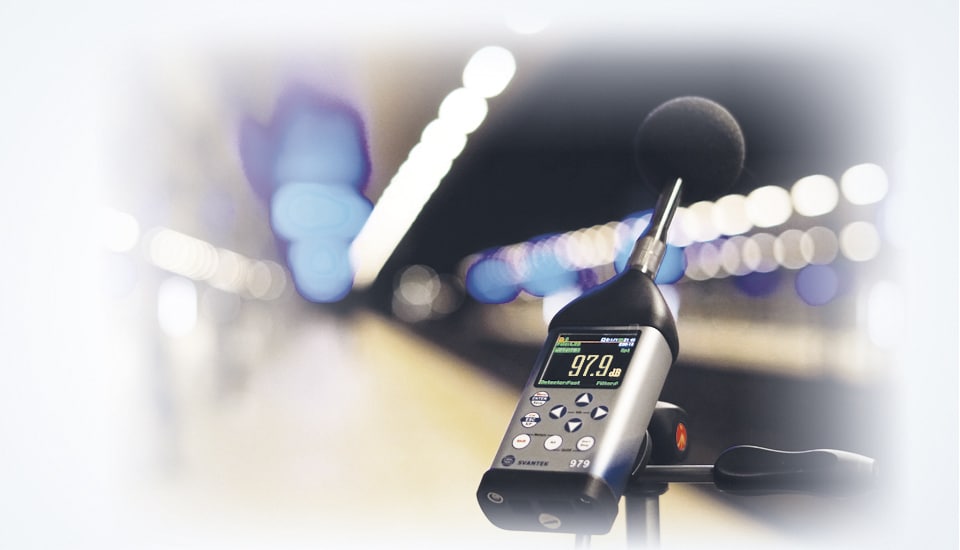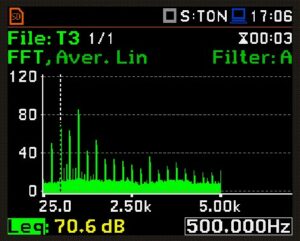Tonality
What is tonality?
Tonality is a measure of sound quality that correlates to how humans perceive the tonal components of sound. The tonality analysis identifies and measures tones in a certain noise spectrum. In acoustics, tonality is a subject of psychoacoustics, which studies the correlation between acoustical stimuli and hearing sensations.
What is a frequency spectrum?
The sound spectrum or a spectrogram is a result of the process of frequency analysis of a sound. The frequency analysis divides the complex sound into octaves or third octaves.
What is the octave band?
A 1/1 octave band is a frequency band where the highest frequency is twice the lowest frequency. In a 1/3 octave band, the highest frequency is 1.26 times lower than the lowest frequency.
1/3 octave tonality example
The yellow color in the left tonality example shows the most pronounced tone. The orange color shows additional tones that are 1/3 of the bandwidth of the highest tone. The red line is the equal-loudness level contour according to ISO 226:2003 that corresponds to the highest tone.

What is a sound frequency?
The frequency of sound is defined as the number of pressure variations per second and is expressed in Hertz (Hz). Thus, a whistle has a high frequency while a distant thunderclap has a low frequency. A sound tone is produced by the sound frequency.
What is a pure tone?
A pure tone is a sound that has just one frequency. In reality, it is uncommon to hear pure tones, and most sounds are composed of a variety of frequencies (broadband noise). For example, even a single note on the piano has a complicated waveform.
What frequency is broadband noise?
Broadband noise includes a range of frequencies. An example of broadband noise is white noise, which resembles rushing water, and is defined as noise that is evenly distributed across the hearing spectrum.
What is the range of hearing?
The human audible range is from 0 dB to 130 dB in the frequency range from 20 Hz up to 20,000 Hz (20 kHz). Although in physics a 6 dB rise doubles the sound pressure, in practice it takes an increase of 10 dB before the sound is perceived as being twice as loud.
What are equal loudness contours?
Equal loudness contours indicate the dB level required at any frequency to give the same apparent loudness as a 1 kHz tone. The human ear is not equally sensitive at all frequencies. It is most sensitive to sounds between 2 kHz and 5 kHz, and less sensitive at higher and lower frequencies. For example, a 50 Hz tone must be 15 dB higher than a 1 kHz tone at a level of 70 dB to give the same subjective loudness.
How the ear detects the frequency of sound?
The eardrum is vibrated by the frequencies of sound that are collected by the outer ear. Three tiny bones transmit the vibration to the inner ear. The basilar membrane has hundreds of sensitive hair cells on its surface. When these hair cells are distorted, they turn into nerve impulses that are sent to the brain.

Environmental Noise Tonality
What is a noise tonality?
Following ISO/PAS 20065:2016 tonality is a presence of a tone in noise, the level of which is below that of the remaining noise components in the critical band about the tone frequency by less than the value of the masking index, av.
What is tonal noise?
Tonal noise is a noise characteristic at the receiver location that includes audible tones. The tonal noise is measured and analyzed with an engineering method or survey method by ISO 1996-2.
What are the tonality annoyance effects?
Environmental noise with a tonal characteristic (e.g. siren sound or air conditioner noise) can lead to noise annoyance. Therefore the prolonged experience of tonal noise can lead to negative health effects, such as noise-induced sleep disturbance.
What is a tone frequency?
Tone frequency is a frequency of the spectral line (or mid-band frequency of the narrow-band filter), to which level the tone contributes most strongly.
What is tone audibility?
Tone audibility is the difference between the tone level and the masking threshold.


What is a masking noise?
Masking noise is the sound that does not belong to the tone, and which limits (masks) the audibility of the tone. In the spectrum, only sound within a certain frequency range around the tone affects the audibility. This range is called the critical band.
What is the critical band?
The critical band is a frequency range with a bandwidth within which is centered on the tone. If a critical band contains several tones, then an energy summation of the levels of these tones is carried out. Tones that lie outside of the critical band contribute to only a minor extent to audibility within the critical band.
What is a tonal adjustment?
The ISO 1996-1:2016 indicates that adjustment (penalty) to the measured sound pressure level of 3 dB to 6 dB is to be added to the measured level if the tone is prominent. The adjustment depends on the audibility of a tone. The goal of adding a penalty to a tonal noise is to express its annoyance.

How the tonality is measured?
For frequency analysis, the A-weighted equivalent continuous sound pressure level, LAeq, should be established based on the respective spectral lines. If the spectrum is unweighted (linear), it should be corrected to A-weighting using BS EN 61672-1. Tonality assessment by ISO 1996-2:2017 requires the determination of the level of the tone and the level of the masking noise in a critical band around the tone frequency. If a critical band contains several tones, then an energy summation of the levels of these tones is carried out.
What are the methods of tone assessment?
There are two main methods of tonality measurement referred to in ISO 1996-2: the FFT method and the 1/3 octave method. The FFT method is described in ISO/PAS 20065:2016 and Joint Nordic Method. The 1/3 octave method is used for example in the UK (BS 4142) and Italy (Italian Law 447/95).
What is the difference between FFT and 1/3 octave method?
The FFT tonality method is more accurate and is applicable for complex sounds such as wind turbine noise. The 1/3 octave is not recommended when the frequency of interest is below 500 Hz.
What is a survey method?
Following ISO 1996-2, the tonality survey method compares the sound pressure level in the 1/3 octave band with the values in the two adjacent two one-third-octave bands. If the sound pressure level in the 1/3 octave band exceeds the level in both adjacent bands then the tone is prominent. The difference level varies with frequency: 15 dB in low-frequency one-third-octave bands (25 Hz to 125 Hz), 8 dB in middle-frequency bands (160 Hz to 400 Hz), and 5 dB in high-frequency bands (500 Hz to 10 000 Hz).
What instruments are used for noise tonality measurements?
Sound level meters meeting the requirements of Class 1 in BS EN 61672-1 shall be used for tonality measurements.
What are the tonality applications?
Tonality measurements examples: Medical Electrical Equipment: Sleep Apnea Therapy Equipment (ISO 80601-2-70: 2015); Motor-operated appliances (household and commercial (CSA C22.2 NO 68); Acoustics — Soundscapes (ISO / TS 12913-2: 2018); ISO 3095: 2013 – Acoustics — Railway applications. The international standards ISO 1996-2:2017 and ISO/PAS 20065:2016 and IEC 61400-11:2012 are used for the windfarm tonality assessment.

FFT Tonality examples
The tonality examples are based on 3-second spectral analysis:
Example 1
Tones found: 7
- Critical band: 203 Hz – 306 Hz;
- Tone level, LT: 50.4 dB;
- Noise level, LG: 25.3 dB;
- Audibility, L: 43.1 dB
- Tonal adjustment, Kt: 6.0 dB;
- Mean L: 56.8 dB;
- U90%, extended uncertainty: 2.5 dB

Example 2
Tones found: 6
- Critical band: 443 Hz – 559 Hz;
- Tone level, LT: 66.1 dB;
- Noise level, LG: 21.3 dB;
- Audibility, L: 31.2 dB
- Tonal adjustment, Kt: 6.0 dB;
- Mean L: 56.8 dB;
- U90%, extended uncertainty: 2.5dB

Example 3
Tones found: 17
- Critical band: 921 Hz – 1.08 kHz;
- Tone level, LT: 85.5 dB;
- Noise level, LG: 27.8 dB;
- Audibility, L: 60.5 dB
- Tonal adjustment, Kt: 6.0 dB;
- Mean L: 56.8 dB;
- U90%, extended uncertainty: 2.5dB

Psychoacoustic tonality
What are the psychometric properties of noise?
Loudness, noisiness, and annoyance are the three psychometric properties of noise.
Why measure tonality?
The objective of tonality assessment is to rate the annoyance of tones. If the noise includes an audible tone, this will make the noise more annoying than indicated by the LAeq. The extra annoyance caused by the tone is accounted for by adding an adjustment to the LAeq.
What is the application of psychoacoustic tonality?
The annoyance of the tonal sound is one of the most important factors for cars and electric vehicles, or other products emitting tonal sounds. Another example of application is noise emitted by telecommunications equipment (ECMA-74).

